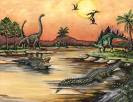The Roman Empire was the post-Republican phase of the ancient Roman civilization, characterised by an autocratic form of government and large territorial holdings in Europe and around the Mediterranean.[5] The term is used to describe the Roman state during and after the time of the first emperor, Augustus.
The 500-year-old Roman Republic, which preceded it, had been weakened and subverted through several civil wars.[nb 2] Several events are commonly proposed to mark the transition from Republic to Empire, including Julius Caesar's appointment as perpetual dictator (44 BC), the Battle of Actium (2 September 31 BC), and the Roman Senate's granting to Octavian the honorific Augustus (4 January 27 BC).[nb 3] Roman expansion began in the days of the Republic, but reached its zenith under Emperor Trajan. At this territorial peak, the Roman Empire controlled approximately 6.5 million km²[6] of land surface. Because of the Empire's vast extent and long endurance, Roman influence upon the language, religion, architecture, philosophy, law, and government of nations around the world lasts to this day.
In the late 3rd century AD, Diocletian established the practice of dividing authority between four co-emperors, in order to better secure the vast territory. During the following decades the empire was often divided along an East/West axis. After the death of Theodosius I in 395 it was divided for the last time.[7]
The Western Roman Empire collapsed in 476 as Romulus Augustus was forced to abdicate by Odoacer.[8] The Eastern Roman or Byzantine Empire ended in 1453 with the death of Constantine XI and the capture of Constantinople by the Ottoman Turks led by Mehmed II.[9]
Thursday, July 8, 2010
Subscribe to:
Post Comments (Atom)

No comments:
Post a Comment